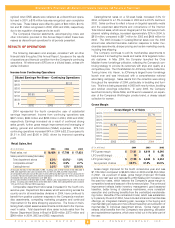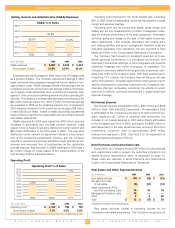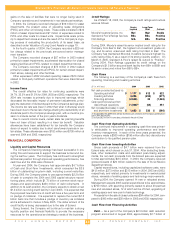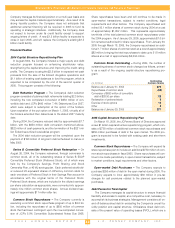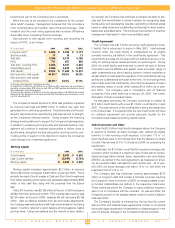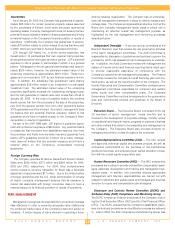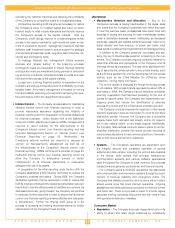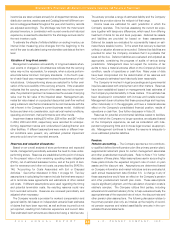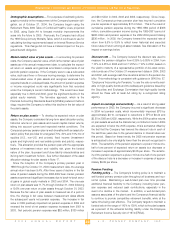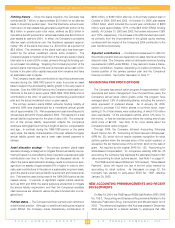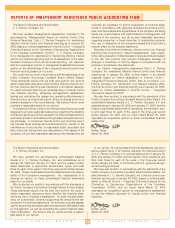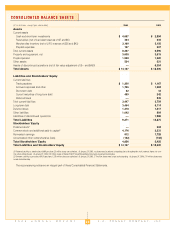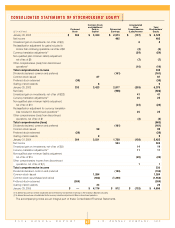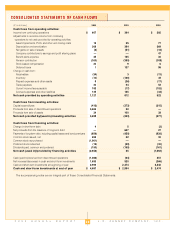JCPenney 2004 Annual Report Download - page 20
Download and view the complete annual report
Please find page 20 of the 2004 JCPenney annual report below. You can navigate through the pages in the report by either clicking on the pages listed below, or by using the keyword search tool below to find specific information within the annual report.
J.C. PENNEY COMPANY, INC.2 004 ANNUAL REPORT
Management’s Discussion and Analysis of Financial Condition and Results of Operations
18
offering stylish quality merchandise assortments at
competitive prices, but equally on the maintenance of its
reputation among many constituents – customers, suppliers,
investors and regulators, as well as the general public – for
business practices of the highest quality.
Attention to integrity and reputation has always been a key
aspect of the Company’s practices and maintenance of reputa-
tion is the responsibility of everyone in the organization. The
Company supports this individual responsibility in many ways,
including a code of ethics, training, policies and oversight func-
tions throughout the organization.
•Competition, Economic Conditions and Customers’
Changing Tastes and Values —Competitive risk, the economy
and consumer attitudes are each important risk factors that could
impact a retail channel’s or the entire Company’s performance.
The Company monitors its market share and its positioning in the
retail market and adjusts its strategy as appropriate. Typical
adjustments might include relocating stores, reviewing
merchandise offerings or pricing, changing merchandise
allocations among various store formats and locations based on
customer demand shifts and changing marketing programs.
The Company has multiple selling channels (e.g., department
stores, catalogs and the Internet), and many different product
lines, both by type of product (e.g., home, apparel, accessories
and jewelry) and brand (i.e., national, private and exclusive).
These factors provide diversification and a level of mitigation rel-
ative to the Company’s overall market risk.
While there is a risk of deflation across the industry, the
Company has been working with suppliers to enhance the fabri-
cation and features of its products, giving its customers a better
product at a competitive price. Given the Company’s high per-
centage of private label merchandise, management believes that
the Company continues to be in a better position than many of its
competitors and does not expect deflation to be a significant fac-
tor in 2005.
In addition, while the Company has processes in place to
adjust to competitive and economic factors, every company is
subject to unknown or sudden shifts in consumer spending pat-
terns or overall economic factors.
Other Risk Factors
The Company’s business is subject to other risk factors, both inter-
nal and external, that may impact future operating and financial per-
formance, such as regulatory and legal risks, changes in tax laws,
inflation and the possibility of catastrophic events, including the
occurrence of significant weather-related or other natural disasters or
human-made disasters, such as those arising from acts of terrorism.
The Company has a number of integrated programs in place to mit-
igate the financial impact from property losses or third-party liability
claims. Each year, management reviews the level of risk that will be
retained by the Company and the portion of risk that will be support-
ed by conventional insurance contracts.
CRITICAL ACCOUNTING POLICIES
The application of accounting policies necessarily involves judg-
ment and, in certain instances, the use of estimates and assump-
tions. Different amounts could be reported under different conditions
or using different assumptions. Management believes that the
accounting policies used to develop estimates that are the most crit-
ical to understanding and evaluating the Company’s reported results
relate to: inventory valuation under the retail method of accounting;
valuation of long-lived assets; estimation of reserves and valuation
allowances, specifically related to closed stores, insurance, income
taxes, litigation and environmental contingencies; and pension
accounting.
The Company’s management has discussed the development
and selection of these critical accounting policies with the Audit
Committee of the Company’s Board of Directors and its independent
auditors. The Audit Committee has reviewed the Company’s disclo-
sures relating to these policies in this Management’s Discussion and
Analysis. For a complete list of the Company’s significant account-
ing policies, see Note 1 to the consolidated financial statements that
appear after this discussion.
Inventory valuation under the retail method:
Inventories are valued primarily at the lower of cost (using the last-
in, first-out or "LIFO" method) or market, determined by the retail
method for department stores and store distribution centers, and
standard cost, representing average vendor cost, for Catalog/Internet
and regional warehouses. Under the retail method, inventory is seg-
regated into groupings of merchandise having similar characteristics
and is stated at its current retail selling value. Inventory retail values
are converted to a cost basis by applying specific average cost fac-
tors for each grouping of merchandise. Cost factors represent the
average cost-to-retail ratio for each merchandise group based on the
beginning of period inventory plus the period’s purchase activity, as
calculated on a monthly basis, for each store location. Accordingly,
asignificant assumption under retail method accounting is that the
inventory in each group of merchandise is similar in terms of its cost-
to-retail relationship and has similar gross margin and turnover rates.
Management monitors the content of merchandise in these group-
ings to ensure distortions that would have a material effect on inven-
tory valuation do not occur. The retail method inherently requires
management judgment and certain estimates that may significantly
impact the ending inventory valuation at cost as well as gross mar-
gin. Among others, two of the most significant estimates are perma-
nent reductions to retail prices (markdowns) used to clear unpro-
ductive or slow-moving inventory and shortage (shrinkage).
Permanent markdowns designated for clearance activity are
recorded at the point of decision, when the utility of inventory has
diminished, versus the point of sale. Factors considered in the deter-
mination of permanent markdowns include: current and anticipated
demand, customer preferences, age of the merchandise and style
trends. The corresponding reduction to gross margin is also record-
ed in the period the decision is made.
Shrinkage is estimated as a percentage of sales for the period
from the last inventory date to the end of the fiscal year. Physical


